HSNW conversation with Kathleen GriggsGunshot localization system improves emergency services response to active shooter events
Kathleen Griggs is president of Databuoy. Databuoy Corporation began in 2006 as a defense contracting company specializing in event-driven command and control operations. It has now realigned itself to focus on public safety in the private sector. Databuoy Corporation’s ShotPoint gunshot localization system is a technology aiming to improve the response of emergency services to an active shooter event. ShotPoint uses networked acoustic sensors that automatically detect, locate, and reports the exact time and location of the source of gunfire.

Illustration of ShotPoint technology // Source: DataBuoy
HSNW: In late 1992, John Lahr of the USGS persuaded the city council of Menlo Park, California, to install sensors – which were developed for sensing seismic events – to help the city police locate gunshots. How is Databuoy’s technology different from the one developed by Lahr a quarter of a century ago?
Kathleen Griggs:We can’t comment on other systems except to say that gunshot sensing research is a subject that has been widely published and there are many examples of technologies that have shown gunshot detection works. ShotPoint is based, in part, on a research effort funded by the Defense Advanced Research Projects Agency (DARPA) from 2003-2011, and has incorporated some of the latest advancements in acoustic shot sensing.
HSNW: ShotSpotter, in its Gunshot Location System, patented the “spatial filter” method, in which only very loud sounds (such as gunfire) can reach some of the sensors, but not all of them – thus allowing for the sensing system to discriminate between gun fire and normal community noise. What technology does Databuoy use for such discrimination?
Griggs:Again, I can’t comment on other systems. ShotPoint is based on a patented multi-source acoustic localization approach that measures sound from multiple sensor nodes. That means sensors capture the sound from different vantage points. ShotPoint uses a central fusion processer that collects detection reports from multiple sensors to determine a single solution. This technique serves to reduce multipath errors and false alarms.
HSNW: Do the company’s sensors “listen” to the bullets’ shockwaves, the sound of the muzzle blast, or both?
Griggs:ShotPoint looks for both bullet shockwaves and muzzle blast signals, each has unique acoustic signal properties. If enough detections are made, ShotPoint finds a total solution for shooter location and bullet trajectory. If only muzzle blast is detected than ShotPoint locates the shooter, but does not compute the bullet trajectory. If only shockwaves are detected, then a trajectory can be computed but the exact shooter position is not determined.
